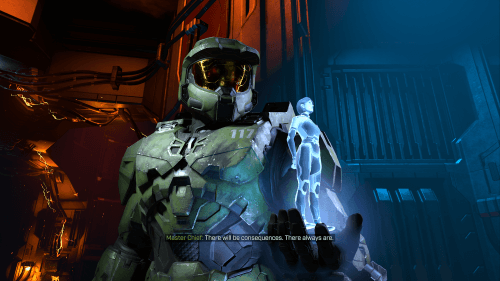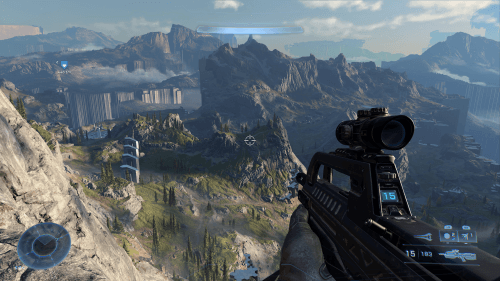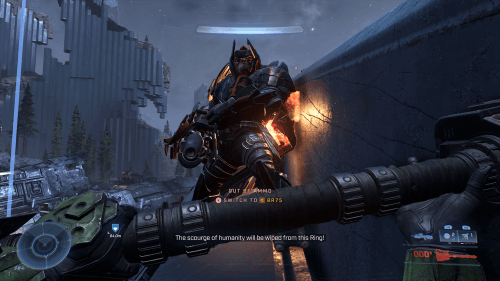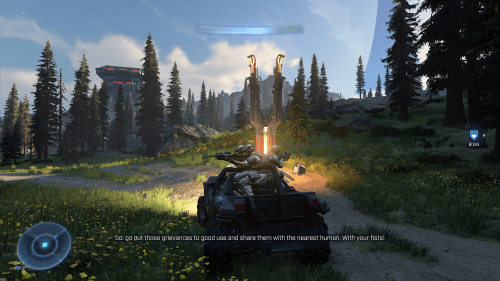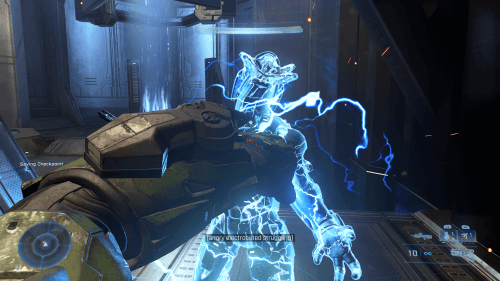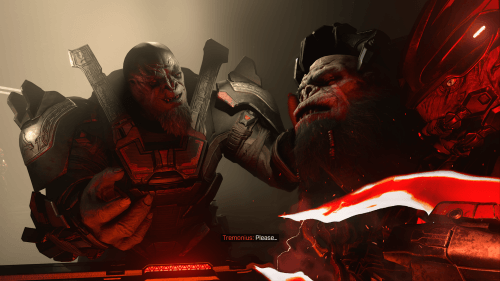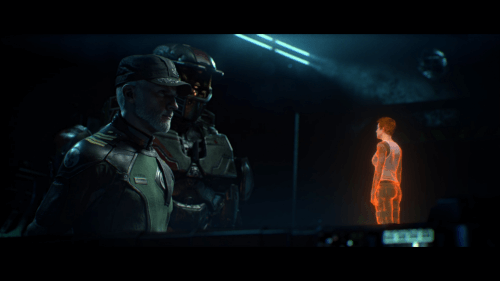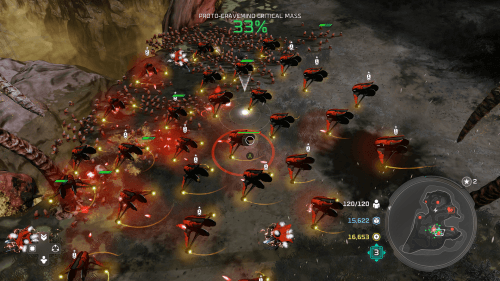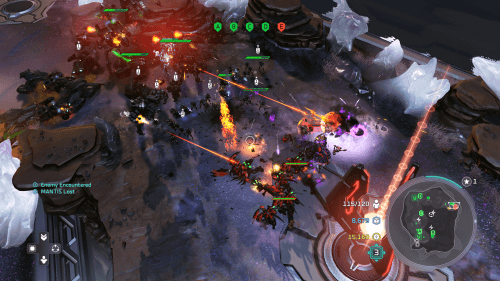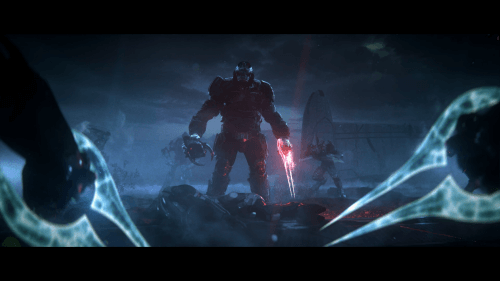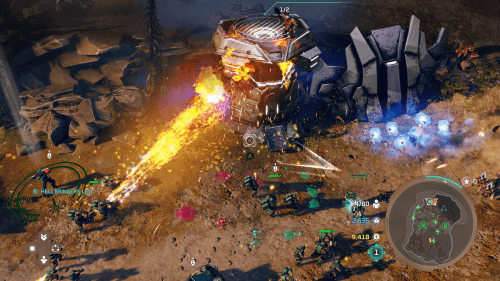It’s time to tie-up my numerous bonus blurbs related to live action teasers and commercials with the culmination of those efforts: 2022’s Halo TV series. While not the Hollywood blockbuster Peter Jackson tried to bring to reality in the mid 2000s, this reasonably big budget Steven Spielberg executive produced television series is the real deal. It’s sad then that when the series launched, there was an awkward mix of excitement around the show’s more impressive qualities, and total rejection of its many deviations from the source material, with the former giving away to the latter as the season went on. While I’ve read things about the show and had the odd conversation about it with friends, I purposely held off watching until after the fervor around it had dissipated.
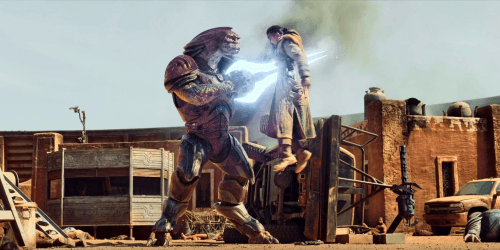
“Ouch. Yeah, Halo is surprisingly violent at times.”
Not too far into the first episode, a fireteam of Spartans is shown dropping into battle and brutally, efficiently, and honestly, kind of scarily, fighting off a much larger force of Covenant. All of the practical stuff, costumes, props, sets, etc. look quite good. Visually, the Spartans themselves are a nice blend of various styles used in the games and other media over the years, and Master Chief is instantly recognizable. Hell, there’s even a first person scene, which I hadn’t anticipated at all. The vast majority of visual effects look great too, and even the ones that don’t (some of the character animation during this particular battle look freakishly unnatural) can be perhaps explained away by the superhuman physical abilities of the Spartans. This first big fight scene isn’t perfect, but it was enough to get a lot of us on the hook.
Then, as the episode moves on, Halo becomes something… different. Let’s go ahead and jump into spoiler territory, because so many of my thoughts from here on out are related to this show’s writing. I’m going to try to be as vague as I can with my plot summary here but I will mention a lot more specifics as I dive into my criticism, so skip to the last two paragraphs if you want to avoid spoilers.
The story: The Covenant attack an Insurrectionist outpost on the planet Madrigal, slaughtering everyone except teenager Kwan Ha, who is saved by the intervention of the UNSC Spartan unit Silver Team. Spartan Master Chief Petty Officer John-117 pursues the remaining Covenant forces to a nearby cave, where he discovers a Forerunner relic. Touching the relic unlocks long-suppressed childhood memories for John, deeply affecting him. As they return to the UNSC base on Reach, Kwan refuses to cooperate with the UNSC, and John is ordered to execute her. Defying his orders, they escape to a pirate base where John reunites with ex-Spartan Soren. Leaving Kwan with Soren, John surrenders to Silver Team and is taken back to Reach. To ensure his stability, Dr. Halsey implants a new advanced AI called Cortana into John’s neural link. Meanwhile, on the Covenant capital station High Charity, the Prophets learn of John’s activation of the relic on Madrigal and send their human ward Makee to retrieve it. As the investigation of the Forerunner relic continues, John touches it again, triggering memories of his childhood home on Eridanus II. These memories prompt him and Halsey to travel there in search of a possible second relic. On Eridanus II, John recalls memories of the second relic’s location, as well as troubling details of Dr. Halsey’s involvement in his abduction into the Spartan program. While the UNSC excavates the second relic, Makee and the Covenant are alerted to its location, launching a successful surprise attack and retrieving the second relic. As the Covenant flee the planet, Makee is purposely left behind. Back on Reach, Miranda Keyes studies the original relic and discovers that it is part of a keystone leading to a Covenant “Sacred Ring” known as “Halo.” During her interrogation, Makee reveals that both she and John possess the ability to activate Forerunner technology. She also suggests that the second piece of the keystone may have been taken to a Covenant holy planet in the Aspero star system. When John tests the Madrigal relic once more, he and Makee share a vision of being on the Halo ringworld together. As John grows closer to Makee, he learns that the Covenant seeks the Halo rings to initiate their “Great Journey.” Desperate to remain at the center of the efforts to reunite the two pieces of the keystone, Dr. Halsey sabotages communications at the UNSC base and takes control of Silver Team, ordering them to capture John, Makee, and the Madrigal relic. In a last-second decision, Cortana chooses to warn John instead of helping to incapacitate him. In the ensuing chaos, Makee is able to take the relic and escape. Upon learning of Halsey’s betrayal and Makee’s escape, Cortana and John deduce the location of the Covenant holy planet and lead Silver Team on a mission to recover both Forerunner relics. They arrive just in time to witness Makee activate the combined keystone, generating a star map. Alerted to their presence, the members of Silver Team are soon overwhelmed by the much larger Covenant force. During the battle, Makee is shot, shutting down the star map before revealing the final location of Halo. Sustaining a fatal hit himself, Cortana assumes complete control of John, rescuing the members of Silver Team and escaping with both pieces of the keystone. Meanwhile, Kwan convinces Soren to take her back to Madrigal to reunite with the Insurrectionists. There, she learns that her family had been entrusted with protecting a Forerunner portal on the planet. Determined to continue her family’s mission, she begins to search for the portal.
First off, Halo the TV series is not canon, taking place in its own “Silver Timeline.” Smart move, as there are various departures from the games that would otherwise have fans eating their own faces. Things like Master Chief acting very, very differently and major changes to other characters, like Captain Keyes being more involved with UNSC command rather than the captain of a cruiser, and Miranda Keyes being a scientist like her mother instead of a ship’s captain herself. There are numerous, mostly small changes like these peppered throughout the entire series, but adding them up, they drastically change core parts of the backstory and timeline of the extended Halo fiction. I mean, some of you probably noticed by the summary above that the plot itself totally rewrites the events leading up to first reaching Alpha Halo in Halo: Combat Evolved.
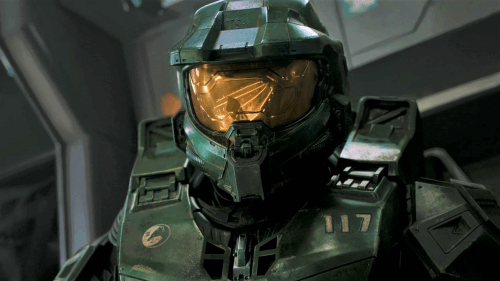
“A rare shot of Master Chief wearing his helmet.”
As mentioned, John doesn’t really behave like the Master Chief we know. He switches between the cold professional you’d expect, and being emotionally disturbed by memories of his childhood and other truths he comes to learn throughout the season. As mentioned in my brief review of Homecoming from Halo: Legends, I actually really like the concept of exploring this facet of the SPARTAN-II program. Not with John-117 though! We know him, and we already know this isn’t something he struggles with, making this feel bizarrely out of character. Now, this can all be forgiven by the Forerunner relic affecting him when he first touches it. It’s easy to gloss over, but the show explicitly tells us this is the case, with others around him mentioning that he seems to be acting quite differently. That doesn’t make it much easier to sell to Halo fans, especially when he’s taking his helmet off all of then time. Yes, that’s a silly nitpick! Still, when he first contemplates taking it off he explains to Kwan why he should always keep it on, and I accepted the idea of him later taking it off to gain her trust, but for the rest of the season it seemed like he was always looking for any excuse to pull it off.
Speaking of, I don’t actually take any major issue with Pablo Schreiber as John-117. He has a reasonably similar voice, mannerisms, and is built like a brick shithouse, just as a SPARTAN-II should be. If the script had him acting more like Master Chief from the games, I doubt too many people would have a problem with it. I… do hate his beard though. I mean, it would make sense that if he was in his Mjolnir for days or weeks he might need a shave, but I’d have preferred to see him clean shaven, looking more like a member of the military, when back on Reach. Now that is a silly nitpick! 😀
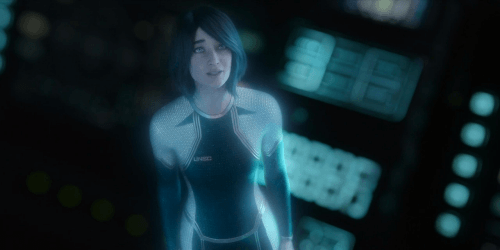
“Cortana gets gradually less creepy as the series goes on.”
Now Makee, AKA the Blessed One, is definitely a controversial character. Personally, I found her portrayal as someone essentially raised in Covenant captivity to be unconvincing on multiple fronts, from petty stuff like her hair style and clothing, to her apparent levels of education and socialization. Beyond that, the idea that the Covenant might want to capture their own “Reclaimer” and treat them as religiously significant actually works for me. I’m also not all that bothered by her and John having sex. Again, blame John being emotionally disturbed by the relic. If anything, the show sets up this bond between the two characters, both in emotionally compromised positions, and both with this apparently rare connection to the Forerunners, acceptably well. It was unnecessary, sure, but at least it wasn’t a full fledged romance subplot.
Last but not least, Cortana. Her visual presentation is strangely off-putting, perhaps in an “uncanny valley” sort of way. Having her be voiced by Jen Taylor really helped though. Still, she’s not exactly the Cortana we know. You know, I’m still not entirely sure how taking over John’s body once he’s physically dead is supposed to work. Hmm! Regardless, the one thing I did like about this version of Cortana is how she gradually came to side with John over Halsey, with John first regarding her as little more than a nuisance, and slowly starting to see her value as well. It’s honestly probably more compelling than how Cortana and Master Chief’s relationship started in the games.
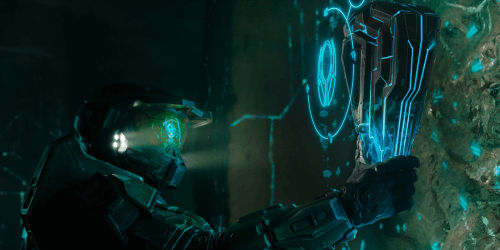
“What does it do? It’s a plot device, obviously!”
Season 1 mostly revolved around the Forerunner keystone itself. While I enjoyed the mystery surrounding it early on, the fact that it was a total MacGuffin, capable of doing whatever the writers needed it to at any point in time, felt incredibly lazy. Really, the way all of this Forerunner stuff presented is a bit over the top. The crazy guy on the Rubble who ranted at John felt totally out of place to me, and Kwan’s weird desert warrior maiden mystics had me absolutely rolling my eyes. Most egregious though, is the concept that John is more or less unique in his ability as a “Reclaimer”. In the games this was never implied to be a rare trait in humans, but in the TV series it is heavily implied that his connection to Forerunner technology is perhaps the reason he is such an exceptional Spartan in the first place. Come on, isn’t being just an exceptional human being good enough without having to tie his existence into some kind of ridiculous destiny?
At this point I feel like I’m really just picking out silly shit to complain about here. There’s a lot to like as well. The fight scenes, though few and far between, continued to be excellent throughout the season, with the one in episode 5 when the Covenant show up to Eridanus II being the highlight of the entire season. I was especially impressed with some of the hand to hand combat choreography, with the Silver Team fight being a thousand times more enjoyable than Locke and Chief’s showdown in Halo 5. I also found myself to be reasonably intrigued by the core plot at the beginning, and as the season got into its later episodes and the pieces started to align more cleanly, I totally got what the writers were going for with the vast majority of their decisions.
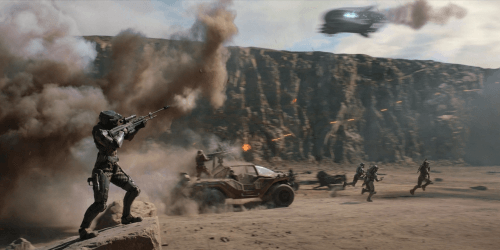
“The lengthy battle in episode 5 might justify the show’s existence on its own.”
It’s sad then that this show is so much closer to being good than I would have suspected. I don’t mean “close to being good” as in “eh, it’s pretty good!” I mean, as a Halo fan, it kind of sucks. Change and tweak a few things and it could have been great, though. Why not have the lead be some other Spartan we’d never heard of before instead of John-117? I mean, realistically, they had to know that Halo fans would never be satisfied with any depiction of Master Chief that wasn’t wearing a helmet 24/7 and voiced by Steve Downs. This could have also alleviated almost all of the above complaints about the show, and perhaps even kept it canon to boot. The pacing was also totally off, both at the season and the per episode level, and that’s an issue regardless of if you’re coming into the show as a Halo fan or not.
Some harsh words, but I definitely plan on watching season 2 when it’s released in 2024. At this point, I’m just fascinated to see where they take the show. With a new showrunner, will they try to correct some of the first season’s missteps? Can they, even? That said, season 1 apparently did quite well, with good ratings and decent critical reviews, so maybe, in a way, the series has achieved the crossover success they were hoping for. I just wish they didn’t leave us Halo fans behind in the process…
